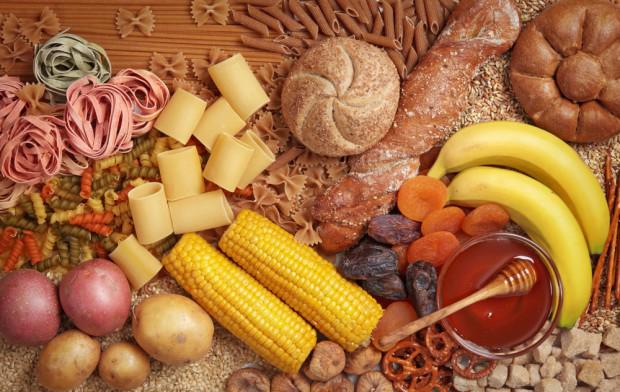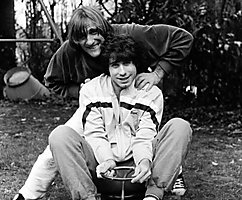Why eat carbohydrates and dangerous than the low-carb diets
 Bashny.Net
Bashny.Net

In this age of growing fashion for a healthy diet and low-carb diets good old carbohydrate losing popularity much faster than their crossed out from the diet passionate wrestlers are overweight - their weight. But everything, as usual, is not so simple and clear: carbohydrates, of course, should be eating, but why and how - below Kuderova says Julia, a certified expert in the field of healthy lifestyles, the author of the blog Zozhnik.
blockquote>
For some reason, people decided to declare war on carbohydrates. We were afraid of the universal "belkomaniya", so let's find out what carbohydrates and again discuss the principles of proper nutrition.
What is this? In terms of carbohydrate chemistry - a class of organic compounds, which include carbon, oxygen and hydrogen. In the body, there are only about 2-3%, which are deposited in the form of glycogen (roughly speaking, the operational reserve of energy). 5-6% of the total liver mass, 0 to 5% of the heart and skeletal muscles of 2-3% - the carbohydrates.
The body of 70-pound male about 500 grams of glycogen, but apart from him there is glucose, which is in free form "floats" in the blood. Its quite small - about 5 grams. The more people trained, the more it can store glycogen.
The human body can synthesize carbohydrates, but in small amounts, however a major amount of carbohydrate is supplied in the diet. Carbohydrates are found mainly in plant foods. For example, in their grains contain about 80% of the total dry weight. And the example of sugar - is generally at 99, 98% carbohydrate.
What are they? Do carbohydrates have their tasks:
Energy: carbohydrates provide 50-60% of daily energy consumption of the body. The oxidation of 1 g carbohydrate 17 kJ of energy is released or a more familiar to us 4, 1 and 0 kcal, 4 grams of water. So when you stop eating carbohydrates, you first "merge", ie of you out previously stored water. This process has many mistaken for true fat burning, while only depleted glycogen stores.
The main source of energy for us - it is stored in the liver and muscle glycogen and free glucose in the blood, which are formed from ingested carbohydrates.
Plastic or construction: from carbohydrates "build" some enzymes, cell membranes, they are also part of the complex of proteins and polysaccharides, cartilage, bone and other tissues. Carbohydrates are stored as reserve nutrients, and also part of complex molecules (e.g. ribose and deoxyribose) involved in the construction of universal energy source ATP, the 'storage' of the genetic information of DNA and macromolecules contained in the cells - RNA.
Specific: carbohydrates for example, act as anticoagulants, that is doing so that the blood does not clot at the most inopportune moment. Are the number of receptors hormones or pharmacological agents, ie hormones help identify where and in what quantities they need. They also exert an antitumor effect.
The stock of nutrients: carbohydrates accumulate in the skeletal muscle, liver, heart and other tissues in the form of glycogen. Glycogen - a bystromobilizuemy energy reserve. The function of the liver glycogen - to provide whole body glucose, glycogen in muscle function - to provide energy physical activity.
Safety: complex carbohydrates are part of the components of the immune system. Mucopolysaccharides found in mucous substances which cover the surface of the nose vessels, bronchi, gastrointestinal tract, genitourinary tract and protects against penetration of bacteria and viruses, and also against mechanical damage.
Regulatory: fiber food can not be a process of splitting in the gut, but activates the intestinal peristalsis, the enzymes used in the digestive tract, improving digestion and absorption of nutrients.
What are they?
Breads, cereals, pasta, vegetables, fruits, sugar - it's all herbal products, which consist mainly of carbohydrates, or mono-, di- and polysaccharides.
Monosaccharides: is the simple carbohydrates that do not fall under the influence of digestive enzymes. Glucose and fructose - a monosaccharide, which are found in many fruits, juices, honey and sugar is called. In the body they come by themselves, if you, for example, eat a spoonful of sugar, or formed during the digestion of more complex carbohydrates.
Once in the body is a lot of free glucose, activates the pancreas, which secretes the hormone insulin, whereby glucose is redirected into the tissues, where it is used for the synthesis of glycogen, and at considerable excess - and for the synthesis of fats (here it is the effect of the extra cakes and abuse fruit juices!) to monosaccharides we were friends, not enemies, their number in the diet should not exceed 25-35% of the total amount of carbohydrates eaten per day.
Roughly speaking, for every 2 teaspoons of sugar (monosaccharide or simple carbohydrates) have to eat 100 grams of oatmeal (complex carbohydrates).
Today very fashionable to replace glucose fructose under the auspices of that - it is allegedly more helpful and it is not stored as fat. This is not true: glucose and fructose - siblings. They are distinguished only that glucose contains an aldehyde functional group, and fructose - keto.
Disaccharides: is part of oligosaccharides, which consists of 2-10 monosaccharides. The main disaccharides - a sucrose (common table sugar), which consists of residues of glucose and fructose, maltose (malt extracts of cereals, sprouted grains) or two interconnected balance of glucose, lactose (milk sugar) has in its composition the remainder of glucose and galactose. All disaccharides have a sweet taste.
Polysaccharides: is a complex carbohydrate consisting of many hundreds or thousands of linked monosaccharides. This type of carbohydrates found in starch (potatoes, cereals, bread, rice, etc.) In the "animal starch" - glycogen in dietary fiber and pectin (fruit, vegetables, cereals, legumes, bran, etc.) And easily digestible inulin ( Jerusalem artichoke, chicory root, onion, garlic, bananas, barley, rye).
How much carbohydrate? RAMS WHO recommends eating 4 g of carbohydrate per kg of body weight. That is for women weighing 60 kg is necessary to eat 240 grams of carbohydrates. It is about 360 g boiled rice round, or 1, 5 kg of boiled potatoes, or 2, 6 kg of sweet apples, celery or 12 kg.
4 g per kg body weight - a recommendation for inactive people. For slightly to moderately active rate of 5-6g for a moderately active (eg 3 weight training a week for an hour) - 6-7, the athletes also recommend eating at least 8-10 grams of carbohydrate per kg of body muscular.
What if without them? Risks protein (carbohydrate-free) dietDa people - protein form of life that can exist without the use of carbohydrates in the food, but it's unhealthy, illiterate and in the long term harm to health. Because reduction of the content of carbohydrates in the diet enhances disintegration of cellular proteins, fat oxidation and the formation of ketone bodies, which can cause acidosis, i.e. increased acidity in the body.
Typically, the oxidation products of organic acids are rapidly removed from the body, but starvation or low-carb diet, they linger in the body, which in the best case leads to the appearance in the urine acetoacetic acid and acetone, and heavy can lead to coma (it happens with diabetics).

The "dyukanovtsev" metabolic acidosis occurs - with a lack of carbohydrates in the tissues accumulate acidic foods, that is, there is a keto or lactic acidosis.
Ketoacidosis is caused by deficiency of insulin. When you eat carbohydrates critically low (less than 2 g per kg of body weight) for quite some time, the body fuels itself with energy due to glycogen and stored up fat. The brain also gets energy mainly utilizing glucose and acetone for it is a toxic substance. Direct lipolysis can not provide the necessary energy for the brain, as well as the glycogen is relatively low (500 g) and depleted during the first days after the rejection of carbohydrates, the body can provide brain energy or via gluconeogenesis (internal glucose synthesis) or by increasing the concentration of ketone bodies in the blood to switch to other tissues and organs in the alternative energy source.
Normally, with a deficit of carbohydrate food liver from acetyl-CoA synthesizes ketone bodies - there is ketosis without causing electrolyte imbalance (which are normal). However, in some cases, hard-edged as possible decompensation and the development of acidosis and may result in diabetic coma ketoatsidoticheskaya.
Fats in the low-carb diet burned worse than normal, balanced diet, as usual fats are connected with carbohydrates for later conversion into energy, and with a lack of carbohydrates occurs defective fat burning, and by-products - ketones that build up in the blood and urine, It is causing ketosis. Ketosis leads to a decrease in appetite (the body thinks it is on the verge of survival), reduced working capacity, weakness, fatigue and irritability are becoming the norm.
Bust with uglevodamiSistematichesky bust carbohydrates leads to the predominance of fermentation processes in the gut, as well as obesity, atherosclerosis, Type II diabetes, as part of the carbohydrate is converted into fat and cholesterol that are dead weight on the internal organs, on top of our beautiful muscles and otherwise harm circulatory system.
In order to be healthy actually have to be able to meet the needs of the body in a way that was good throughout the body as a whole, while remaining within the normal healthy. It is important that all the senses (including your brain) happy meal to meal gave positive emotions.
via factroom.ru
Tags
See also
Office in Berlin than Russian startups differ from German - and why you need geoservices good old shopping offline
Vadim Zeland: Dangerous than talk about health with friends and family
The more dangerous for women training if the leading man
Diet day 3 plus of the diet
California diet —the secret to Marilyn Monroe
Why suffer from gluten and fat — learn the truth!
Stress leads to obesity
What ages us
Find out the TRUTH! What are the dangers of red and processed meat




















